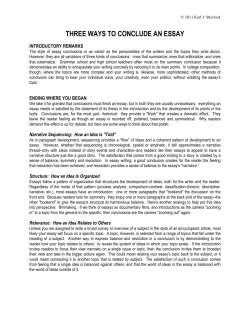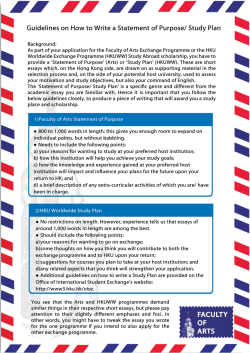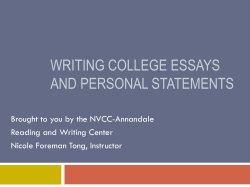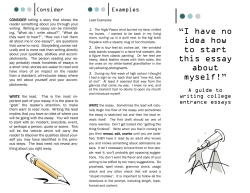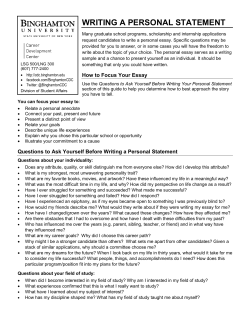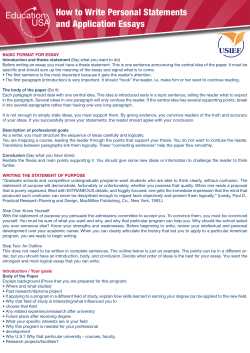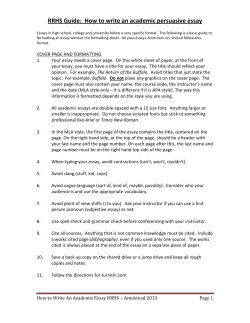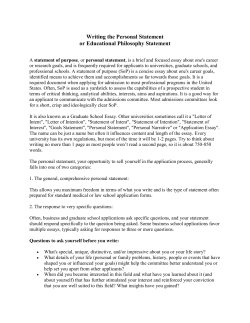
How to DBQ
HowtoDBQ Modified from the work of Bill Strickland and Bill Zeigler – both extraordinary AP World gurus and readers on the AP World exam General Advice for All Essays Remember the overall structure of the APWH Exam? On the day of the national exam, you’ll have just finished 70 Multiple Choice questions in 55 minutes. You’ll then have a 5-10 minutes break before starting the Essay section. Below is a table summarizing how the Essay Section fits into the overall exam. Section Multiple Choice Weight 50% # of Questions 70 Time Allowed 55 minutes Suggested Pace approx. 45 seconds per question Free Response (Essays) 50% 16.67% 16.67% 16.67% COMP Comparative CCOT DBQ (Compare and Continuity and Document Based Contrast) Change Over Time Question 10 minutes mandatory reading period, then 120 self‐budgeted minutes to write all 3 essays 40 minutes 40 minutes 40 minutes When the Essay section begins, you’ll receive a green booklet containing all three essays questions: the DBQ; the CCOT; and the Comparative. You have 10 minutes to read all the questions, including the documents for the DBQ, take notes, and plan your essays. You are NOT allowed to actually begin writing during these 10 minutes. One of the biggest mistakes students make when they take the APWH Exam is not using the 10-minute mandatory reading period to plan and outline their essay writing. Think of these 10 minutes as an opportunity to “write a rough draft” of each essay. Obviously you can’t write three entire drafts in 10 minutes, but you can write a rough outline (draft) of what you want to include in your essays. As the next two hours unfold, you can then look back over your notes and outline to make sure you write as good an essay as possible. You do not have to write the DBQ first, but can write the essays in any order. Also note that while the exam proctor may remind you that “you have x minutes remaining,” you can spend as much or as little time as you want on each essay, so you’ll need to be self-disciplined in order to write three high-quality essays in the time allowed. Core Scoring Next, realize that APWH essays are graded according to a rubric. The rubric for each type of essay is slightly different, but all three essays’ rubrics require the essay to satisfy 5-6 “Core” characteristics. If, and only if, all of these “Core” characteristics are satisfied, then the essay is eligible for “Expanded Core” (extra credit) points. The “Expanded Core” categories are basically just the same as the Core categories, but require a higher quality of performance. The Rubrics are structured this way to encourage students to write well-rounded essays. On a practical level this means it is crucial to know what the “Core” characteristics are so that one can satisfy all the “Core” requirements, as well as then possibly earning “Expanded Core” points. The “Core” characteristics are worth 7 points, while the Expanded Core is worth 2 additional points. Thus, the maximum possible score for each essay is 9. Asset Model One last thing to note is that the scoring of the essays is done on a so-called asset model. That is, the scorers want to give you every point that you deserve and are looking for every opportunity to do so. What this means, practically speaking, is that they will read over your errors rather than remove points. So, be daring and do everything that is required and more. Do not let fear of errors hold you back to a timid standard on the AP World History essays. Study the rubrics in this section so that you know what is scored on each essay. *********************************************************************************** Purpose of the DBQ The purpose of the DBQ is to test students’ ability to do what professional historians actually do: use and interpret historical documents to make conclusions based on those documents. It is NOT a test of students’ prior knowledge (you’re not expected to know anything about the topic before the exam) but rather a test of students’ skills to perform a variety of analytical tasks. Why is this important to realize? When you first read a DBQ question, you will most likely have absolutely no idea about the topic. Relax! That’s normal. No one is supposed to know anything about the topic. That’s what makes a DBQ a “level playing field.” No one has any advantage over anyone else. The DBQ “Core” Rubric Official Description 1 2 3 4 5 6 Has an acceptable thesis Addresses all of the documents and demonstrates understanding of all or all but one. Supports thesis with appropriate evidence from all or all but one document. Supports thesis with appropriate evidence from all or all but two documents. Analyzes the context of at least two documents. Analyzes documents by grouping them in two or three ways, depending on the question. Identifies and explains the need for one type of appropriate additional document or source. Points Plain English Description 1 Thesis 1 Meaning of Documents 2 Evidence 1 1 Context 1 Grouping 1 Additional Document Up to two “Expanded Core” (extra credit) points can be earned for doing any of these “Core” tasks exceptionally well, but remember that ALL seven of the “Core” points must be earned before an essay is eligible for “Expanded Core” credit. Although the DBQ Rubric lists six “Core” characteristics, that does not mean that students should necessarily write the essay in the order of these characteristics. The Rubric is meant as a guide for essay Readers to score the essay, not as an outline for students in how to write the essay. We are going to be practicing this week with two different DBQs from this past unit. The charts that follow will help walk you through the process of writing a DBQ. By the end of the week, you will be writing an actual DBQ. All work we do this week will go in to the writing category of your grade. Step 1: Analyze the Question Question What is the question asking you to do? (What’s the verb in the question? Restate the verb in your own words.) What? (the topic) Where? (the place) When? (the time) Based on the following documents, analyze the responses to the spread of Buddhism in China. What additional kind of document(s) would you need to evaluate the extent of Buddhism’s appeal in China? Using the documents, analyze Han and Roman attitudes toward technology. Identify one additional type of document and explain briefly how it would help your analysis. Step 2: Historical Background The Historical Background is presented in most (but not all) DBQs in order to “jog the memory” of students. Unfortunately too many students don’t realize that the HB paragraph is there to help them and all too often ignore it or don’t realize that it contains valuable information. Historical Background Try to summarize the Historical Background (HB) paragraph above. What kind of information does it give you? Are there any hints in the HB paragraph that will influence how you read, interpret, and categorize the documents? Based on the information in the HB, how are you going to read the documents any differently than you would if you hadn’t read the HB? After all, the writers went to some effort to give this HB information. What use will you make of it? Historical Background: Buddhism, founded in India in the sixth century BCE, was brought to China by the first century CE, gradually winning converts following the collapse of the Han dynasty in 220 CE Buddhist influence continued to expand for several centuries. Between 220 CE and 570 CE, China experienced a period of political instability and disunity. After 570 CE, the imperial structure was restored. None Provided Step 3: Reading and Analyzing Documents What notes should one take as one reads the documents? Much of that depends on the question being asked, but there are several common characteristics in each document that one should look for because any of these characteristics can influence how a document should be interpreted and analyzed. The acronym “SOAPSTONE” is often useful as a guide for these characteristics. Subject What is the main topic of this document? Occasion When was this document produced? Was it created for a particular event or occasion, or even during an era when other similar documents were produced? Audience Who was this document’s intended audience? Was the document written to be read privately by a specific person (who?), a public announcement, or an official proclamation? Purpose Why was this document produced? What was the purpose or motivation of the writer/author of the document, based on what limited information you have about them? What effect did the author hope this document would have? What did the author want the reader(s) of this document to do? Speaker Who was the Speaker of this document? Was it an official person representing a government, or an informal, anonymous individual? Usually a document’s author and speaker are the same individual, but occasionally they may actually be different. (e.g. a speech may be written by a speech writer, but spoken by a government official) Tone Is there any apparent tone or “voice” in this document that would influence one’s interpretation? Is it filled with any apparent emotion? (e.g. sarcasm, exuberance, anger, disdain, admiration, etc.) Underline any unusual vocabulary in the document that serves as a clue to this interpretation. As you read each document, write a brief note above and to the left1 of each document regarding these characteristics. Do worry if you can’t detect answers for every “SOAPSTONE” category. No single document will have complete answers for all these categories, just do the best you can. If you get in the habit now to write your comments on each document in a uniform manner you will find it much easier to organize your paragraphs later. Step 4: Additional Document After you read a document, you’ll notice that some of the SOAPSTONE characteristics you looked for were answerable, but others weren’t. Below and to the left of each document write down a type of document that would complete the missing information not contained in the given document. Sometimes it is helpful to think of the Additional Document as a “Missing Voice.” Who would be a good type of person (not already heard from) to create a document that would help answer this question, and what information would that person likely have? You don’t have to name a specific, actual document, but you must do two things with this Additional Document: 1. Describe the kind of document that would give more information, or the kind of information you would like to see in an additional document. 2. A short explanation of how that information would help a historian answer the question more completely. (You can’t just write, “…because it would answer the question more fully.”) Original Question Based on the following documents, analyze the responses to the spread of Buddhism in China. What additional kind of document(s) would you need to evaluate the extent of Buddhism’s appeal in China? Using the documents, analyze Han and Roman attitudes toward technology. Identify one additional type of document and explain briefly how it would help your analysis. Missing Voice / Additional Document Type of Information / Evidence How would this document would help answer the question more completely? How would an historian use this document? Sample wording for the additional document “It would help to have a document from a [type of source] that deals with [subject matter] so that historians could better [use information to do what?].” or “It would help to have a [kind of] document showing [description of what kind of information/evidence desired] so that historians could [describe what conclusion you’d like to be able to draw from this evidence].” Step 5: Grouping When you’re finished reading all the documents, look back over your SOAPSTONE notes written above each document on the left side. Do you notice any characteristics that more than one document share? Rewrite these commonly shared characteristics above and to the right of each document. You’ll use this information to plan and structure your paragraphs in a few minutes when you begin to write. Step 6: Context / Point of View (POV) The purpose of the DBQ is to test students’ ability to do what professional historians actually do. Well, what do professional historians do? One essential task is to interpret historical documents. History is not just facts, a large part is also interpretation of facts. This is one area that makes history both fun and controversial, because different historians interpret identical documents differently. Your essay will never be graded according to whether the reader agrees or disagrees with your interpretation of the documents. As long as you “Construct and evaluate arguments using evidence to make plausible arguments” (Habit of Mind #1) your interpretation is perfectly acceptable. It is of course possible to misinterpret documents, which does carry a penalty for Rubric category #2, but as long as you include all the documents somewhere in your essay and misinterpret no more than one document, you’ll earn full credit for your interpretation as long as you can make a plausible case for your interpretation. So as you read and interpret each document, what clues are there that any particular document means anything other than the literal words on the paper? Are there any reasons why although a document says “x” it should be interpreted as meaning something more, less, or different? All the intangible circumstances surrounding a document that influence how one should interpret that document comprise what is called the “Context.” If this concept seems vague or meaningless to you, imagine that two people tell you exactly the samewords. Would you interpret and respond to each person identically, or would you take each person’s identity into account when you weigh whether to take their words seriously? For instance: Document 1 “If you park your car there, you’ll get in trouble,” says your six-year-old sister. Document 2 “If you park your car there, you’ll get in trouble,” says the police officer. You’d interpret these two statements very differently, wouldn’t you? Obviously the identity of the source makes a huge difference in how seriously one interprets the document. Note, however, that one should not come to the conclusion that Document 1 is “wrong” while Document 2 is “right.” (Can you think of any circumstances that might make your sister be correct? Just because she’s six doesn’t mean she’s automatically wrong, it just means that you’d probably want some more information re: the context of your sister’s comments before you render judgment on her words. After all, she might have just heard your parent say, “If that car isn’t moved your older sibling will be punished!”) Context is far more subtle than simply labeling documents as “right” or “wrong.” You have to be very specific in deciding to what degree a document should be interpreted a certain way. Ultimately, you should be able to place each document on a spectrum of the document’s “trustworthiness.” Limitations Value -|-----------|-----------|-----------|-----------|-----------|-----------|-----------|-----------|-----------|-----------|--------|What characteristics limit/reduce the value What characteristics strengthen/enhance the of this document? value of this document? So, how does one interpret a document’s context? The most common ways are listed below. (Some of them are the same SOAPSTONE characteristics you’ve already done!) 1. Who produced this document? Is this author have any special knowledge about the topic? How credible is this author? Discuss the author’s gender, age, ethnicity, social status, religion, level of education, intellectual or political philosophy, etc. (You won’t know all this information, but give as much detail as possible.) 2. When was this document produced? Can it be connected with a significant historical event or era? (Think back to the Historical Background information.) 3. Who was the intended audience? Was the document written to be read by a specific person (who?) a public announcement, or an official proclamation? 4. Why was this document produced? What was the purpose or motivation of the author of the document, based on what limited information you have about them? What effect did the author hope this document would have? What did the author want the document reader to do? 5. Is there any apparent tone or “voice” in this document that would influence one’s interpretation? Is it filled with any apparent emotion? (e.g. sarcasm, exuberance, anger, disdain, admiration, etc.) Underline any unusual vocabulary in the document that serves as a clue to this interpretation. As you read each document, write your Context notes below and to the right of each document. SOAPSTONE • life, desire, = sorrow • only spiritual solution to earthly problems • earliest of documents • purpose: spiritual enlightenment Grouping • Teachings reflected by Zhi Dun (Doc #2) • Inspired followers like Zong Mi for centuries, (Doc #5) • Is cause of all other documents’ reactions Additional Document • How many people agreed with/followed? • Did political rulers support/resist? Context • Buddha was born a privileged prince • Prophesied to be revolutionary figure • Spent his life searching for enlightenment, couldn’t find enlightenment/peace in privilege or asceticism Document 1 Source: According to Buddhist tradition, “The Four Noble Truths,” the first sermon preached by the Buddha (563 BCE-483 BCE), India, fifth century BCE. The First Noble Truth is the Noble Truth of Sorrow. Birth is sorrow, age is sorrow, disease is sorrow, death is sorrow, contact with the unpleasant is sorrow, separation from the pleasant is sorrow, every wish unfulfilled is sorrow. The Second Noble Truth is the Noble Truth of the Arising of Sorrow, it arises from craving, which leads to rebirth, which brings delight and passion, and seeks pleasure-the craving for sensual pleasure, the craving for continued life, and the craving for power. The Third Noble Truth is the Noble Truth of the Stopping of Sorrow. It is the complete stopping of that craving, so that no passion remains, leaving it, being emancipated from it, being released from it, giving no place to it. The Fourth Noble Truth is the Noble Truth of the Way that Leads to the Stopping of Sorrow.
© Copyright 2025

